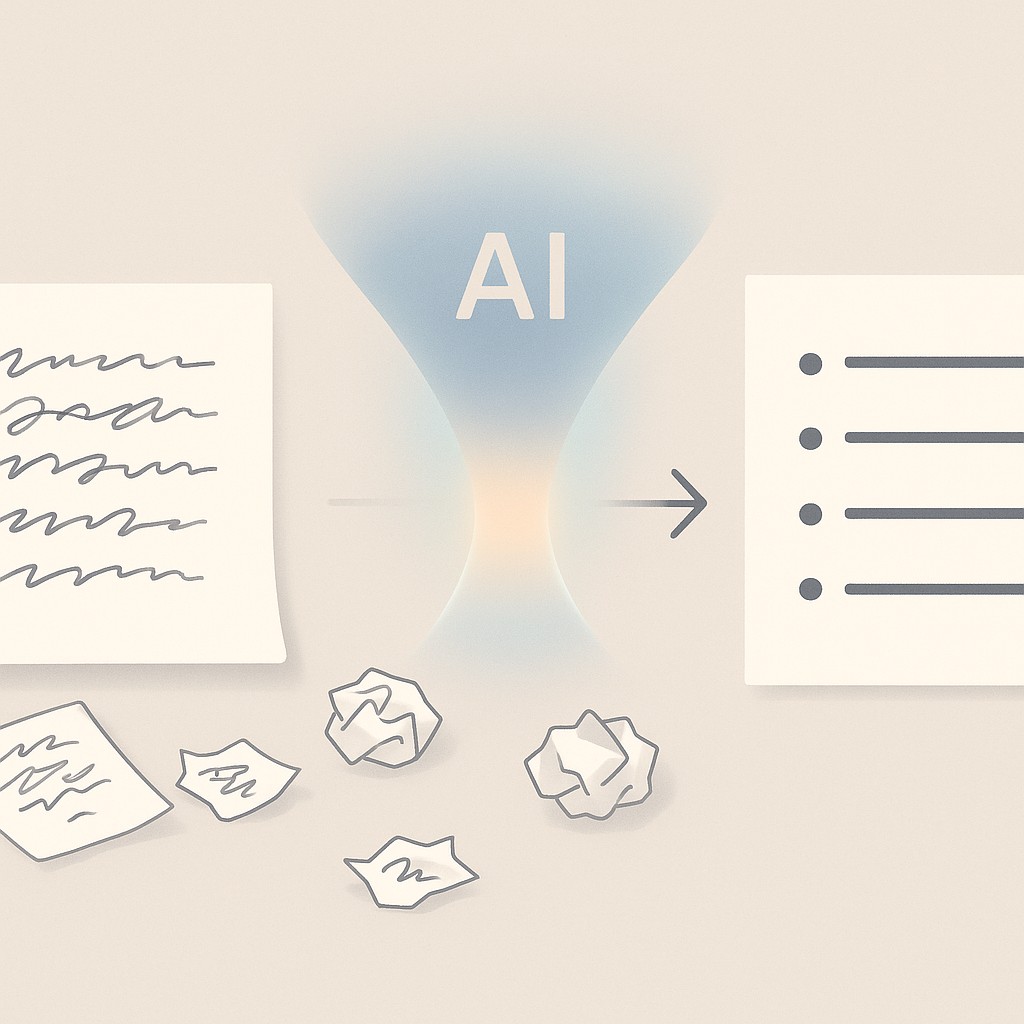Write Clearly with AI: Clarity First for Outcome-Driven Teams
Write Clearly with AI: Clarity First for Outcome-Driven Teams

When Clarity Wins: Write Clearly With AI for Outcome-Focused Execs
Not long ago, I found myself preparing an update for our executive team. It was one of those times when you feel the urge to share everything: technical deep-dives, edge cases, patches you’re proud of. I’d written what felt clear to me, though if I’m honest, I was probably clinging to too much detail. Experience has taught me execs don’t want the inner workings. To write clearly with AI, I made it my translator. I’d write what made sense to me, then prompt it to “rewrite for an exec who cares about outcomes, not details.”
I wish I’d known how much easier this makes things years back: For C-suite roles, social skills top the list over technical details—outcome-focused clarity wins when leaders prioritize communication over granular specification. The relief when my message finally landed—fewer words, straight to the point—was real. The team moved faster, and my brain felt lighter.
We’ve all seen it. The AI blur of polished emails and reports that say less. Maybe you’ve caught yourself rereading something three times, only to realize it was all style, no substance. Recently, this template creep has gotten worse—impressive formatting, friendly filler, but it’s hard to tell what’s actual work. People feel it; I do too sometimes.
The cost isn’t just aesthetic. It’s hours lost. Engineers and leaders untangle glossy, shallow output just to work out what got done and why it matters. Plenty of days I’ve spent more time decoding, verifying, and rewriting these docs than moving the project. The real drain is in that cycle—clarifying things that should’ve been clean up front. I’ve stood on both sides—sending and receiving—and honestly, it’s exhausting.
But I can tell you, it doesn’t have to be that way.
If you start with audience and outcome first, then use AI to translate your mess, distill stray details, and spit back usable updates, you’ll finally get leverage. Setting context up front saves everyone’s cognitive load—including your own. It’s not productivity theater. It’s actual understanding. The wasted email threads and “can you clarify?” pings? They shrink. And alignment—the kind that actually speeds up work—shows up.
Clarity First: The Method to Cut AI Slop and Get Alignment
Leverage comes from clarity. Quantity is a distraction. Here’s the core shift: when your prompts anchor in audience and outcome, you write clearly with AI as it trims away the fluff, so action becomes obvious. You communicate less, but say more. The net effect—everyone knows what’s next. Adapted communication even trims sentences by a third versus originals—anchoring prompts in outcome and audience cuts word count while keeping intent tight. We’re flooded with messages that read like templates, not thoughts, and the only way out is ruthless clarity from the start.

I’ll break down what works for me. I start by explicitly stating what I want to happen—just writing out “What does this exec need to decide? What am I actually asking?” Then I dump my mess of notes and use AI for clear writing to rewrite and compress, staying true to intent. Most days, those drafts are just a pile of half-baked ideas. There’s no shame in it—it’s better to clear the mess for the reader than bury them in it.
If you think this takes longer up front, you’re right. Temporarily, at least. The time spent now is an investment that comes back triple, in less back-and-forth and fewer missed signals. If I’m honest, I’ve wasted way more hours fixing unclear messages than just writing them clean the first time.
Nuance can be a hurdle. I keep the evidence and logic close, but never lead with it. Use layers; start with a TL;DR, put supporting detail in a reference section below. That way, execs get outcomes fast and engineers trace the trail if needed. Kind of like API docs—surface the calls, let the deep divers find the schemas. I wish I’d started this sooner; sharing is now much less painful.
Fad fatigue is real. This can sound like another “work smarter” meme, but I’m allergic to trends with zero substance. Durable habits win. AI is just the nudge that makes the good habits stick easier. That’s all.
Clarity in Practice: Patterns for Real Teams
During annual review season, I skip the narrative—people want impact, quick. Everyone dumps raw wins and moments of ownership and metrics, no filter. Then I pipe it into AI: “Summarize accomplishments for execs, focus on impact.” Doesn’t have to be a work of art. High-density bullets the leadership team can scan come from concise writing with AI. When reporting to outcome-focused folks, speed beats style every time. I care less about elegance than making real work visible.
When my inbox and chats overflow—project updates, stray notes, status pings—I stop trying to keep things neat. These messy fragments are invisible knowledge: progress, blockers, context that vanishes if not captured. I batch it all, dump into AI, say, “Draft a team update, pull dependencies and next steps.” Is it perfect? Never. But it turns ephemeral junk into a living record. Iterating is easier than staring at blank screens. Each step makes it sharper, and suddenly, I’m revising rather than procrastinating.
Three basics: translate for your audience—actually name who will read it and what they care about. Distill your notes into bullets; cut filler, hunt what matters. Assemble a draft with simple structure like summary up top, details below, clear next steps. It’s just scaffolding. Good enough to build alignment, not so bulky it bogs you down.
Funny enough, I learned more about writing clear status updates from a short stint working in restaurant kitchens than from any leadership seminar. You lay out ingredients in sloppy piles, line them up, sort, toss what doesn’t belong. Only then do you plate something worth serving. Some mornings, I wish managing projects felt more like prepping mise en place than herding Slack messages, but that’s probably another discussion for another time.
Outcome-driven AI prompts matter. I keep a cheat-sheet near my desk—one for execs, one for senior ICs, one for product leads. “Summarize for execs with outcomes and risks.” “Compress into bullets for senior ICs.” “Draft a decision note for product.” Pull the lever that matches the need. It isn’t glamorous. But anchoring prompts to stakeholder needs saves headaches later.
Outputs diverge for a reason. An email to execs, shaped by AI for stakeholder communication, spells out outcomes, risks, decisions. It’s short and skips weeds. Notes for peers hold context, blockers, progress. Cutting what your audience doesn’t need is just as critical as choosing what they do—tailoring content sharpens focus and saves everyone’s time. Different people carry different cognitive loads. That’s not just considerate; it’s the payoff. Less noise. Better actions. Fewer regrets about unread updates.
Operationalizing Clarity: Using AI to Align Teams for Real Impact
I still start drafts with “Audience” and “Outcome” at the top. No fancy page setup—just those two lines. It shapes what follows. Who reads? What decision/action is this for? Layer summaries first (execs), hang details below, and let clear asks stand out. Before sending, I prompt AI to call out gaps or assumptions—a habit that’s saved me more than I want to admit. Sometimes I think I’m getting better at spotting my own blind spots, but honestly, I still miss stuff, and double-checking before sending has saved a few embarrassing follow-ups.
Everyone’s talking about work slop—those AI-generated blocks of text that look nice but say little. I try to flip that script; use AI to reduce AI-generated fluff and cut noise, not hide it. If it rings hollow or smells like a template, I ask for sharper thinking and more ruthless trims. AI should force you to get to the point, not pad the word count.
Every clear message saves time twice: yours and theirs. You’ll spot it sooner than you expect—writing speeds up, “wait, can you clarify?” replies drop, email thread sifting goes down. If you actually track replies and rework, you’ll see it. Faster decisions, less repeating yourself. It’s most obvious when that framing up front cuts back-and-forth and you start trusting the project flow.
Closing loops across stakeholders is easier now. Short summaries, links for details, next steps spelled out. I’ve stopped tracking so many threads and actually shipped more alignment. You can see the difference: clarity really compounds when everyone speaks in outcomes.
Clearing Doubts: Invest Now, Align Faster
Sometimes, I’m not sure if all this front-loaded clarity is overkill, or just one more process fad. Six months ago I honestly worried I was doing too much—writing more, not getting to actions quicker. But every time I anchor my process in audience and outcome, it gets more manageable. Doubts pop up, but layered artifacts take care of most. The payoff in saved time and better team understanding is clear. The only thing I still wrestle with is how much context to include. I know trimming matters, but every so often I leave a thread dangling just in case someone needs to connect it. Maybe that’s the part I’ll always obsess about.
Try this: pick one update, jot the audience and what they need, pour rough notes, and prompt AI to distill. Ship a short message and see if the reply cycle drops. If not, tweak the prompt. Principle stays.
Put audience and outcome first, then let our app turn your raw notes into tight summaries, clean bullets, and clear next steps you can ship in minutes.
AI’s power is in framing. Lead with audience and outcome; everything sharpens. Shorter messages, quicker alignment. I write less than ever—communicate more.
Some days, I miss the messy piles of notes. But the plates look better now.
Enjoyed this post? For more insights on engineering leadership, mindful productivity, and navigating the modern workday, follow me on LinkedIn to stay inspired and join the conversation.
